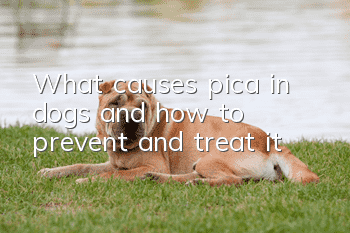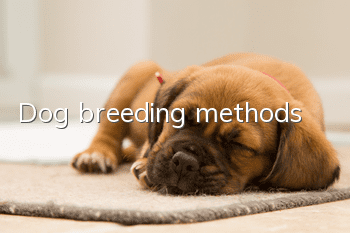What causes pica in dogs and how to prevent and treat it?

I believe that pet owners who raise dogs often see dogs chewing on some strange things, some chewing on the wall, some chewing on the sofa. Owners are also worried that the dog's random eating will have an impact on their health, so the dog will be strange. What causes food addiction? Canine pica: Due to environmental, genetic, nutritional, endocrine and other factors, dogs lick or bite non-food or foreign objects with no nutritional value, which affects normal life.
Clinical manifestations
Depending on the characteristics of the swallowed foreign body, whether it is retained in the digestive tract, and the location of retention, the clinical manifestations of pica are: licking, biting, and swallowing food or bedding, hay, cinders, rags, etc. contaminated with feces.
According to clinical research, pica is not an independent disease, but a comprehensive disease that interacts with many factors such as rickets, indigestion, and chronic parasitic diseases.
Causes of pica
Environmental factors
1. The dog population is kept too densely, the air circulation in the kennel is insufficient, the lighting time and light color are inappropriate, and the dogs are in a bad mood, depressed and irritable.
2. Dogs lack the care of their owners. In order to resolve loneliness, dogs will become curious about foreign objects around them and even their own feces. If the owner does not stop it in time, these behaviors can lead to pica.
Nutritional factors
1. Improper diet leads to a lack of trace elements, or poor gastrointestinal function and indigestion lead to pica.
2. The lack of certain proteins and amino acids leads to metabolic disorders in dogs and the symptoms of pica.
3. Lack of other nutrients, such as calcium, magnesium, phosphorus, sulfur, iron, sodium, copper, cobalt, manganese and other minerals, especially sodium salt.
4. Lack of certain vitamins and trace elements, especially B vitamins.
Disease factors
1. Toxins or stimulation produced by external parasites can trigger pica.
2. Intestinal parasites lead to a decrease in the digestion and absorption function of the intestines, resulting in insufficient nutritional elements in dogs and the development of pica.
3. There are also some endocrine diseases that can cause stress in dogs and lead to pica.
Nature
Dogs are playful, active and curious, especially newborn puppies. They are full of curiosity about various things in the environment and will explore unfamiliar things around them through their mouths. If this behavior is not corrected in time, it will also lead to pica. addiction.
For example, dog feces eating is actually a dog’s nature. If you don’t pay attention to guidance, provide sufficient food, or train well, you will eat feces. You will not only eat your own feces, but also the excrements of other animals. Therefore, once clues are discovered, the owner should stop training in time to avoid becoming a pica.
The dangers of pica
1. Licking sharp foreign objects will damage the mouth.
2. Ingestion of foreign bodies can cause obstruction or perforation in the esophagus, stomach, and intestines.
3. Licking the fur will form hair balls in the stomach that are difficult to digest and excrete. When there are foreign bodies in the digestive tract, dogs will have symptoms such as anorexia or hunger strike, vomiting, etc., which will affect the dog's health.
4. If you eat the excrement of other animals, you will easily be infected and spread diseases.
5. Dogs with pica are prone to panic and are slow to respond to external stimuli; their skin is rough and dull, they have bowed waists, grinding teeth, anemia, alternating constipation and diarrhea, progressive weight loss, and in severe cases, death from systemic failure.
Prevention and treatment of pica
If a dog develops pica, you must have confidence in it, do not dislike it, and care for it more. Try to correct their bad pica behavior in life and help it improve.
Balanced diet structure
1. Choose good dog food: high-quality dog food, which is nutritionally balanced, moderately soft and hard, has good palatability and is easy to digest.
2. The nutritional needs of dogs are different from those of humans. There is no need to supplement carbohydrates and vitamin C. The bacteria in the dog’s stomach can produce enough vitamin C. Feeding humans extra food may also disrupt their own nutritional balance.
Good eating habits
1. The good habit of regular, quantitative and fixed feeding can increase appetite and help digestion.
2. Avoid spoiled dog food. The taste of dog food can be changed according to the situation.
3. Properly provide meat, fat, liver and other animal protein foods. You can also chop celery, rapeseed, etc. and mix them with meat to improve the food for your dog. It’s best to juice carrots and eat them mixed with other foods so that the nutrients will not be lost.
Correct bad behavior
1. Develop good excretion habits, especially during the development period of dogs, guide them to excrete in a fixed place, and remove feces in a timely manner.
2. If you are found licking feces, punish him immediately and complain. If you do not clean up the feces immediately, if you are found to be licking it, punish it again to make the dog aware of the consequences of this behavior and gradually get rid of the bad habit.
3. If you find that the dog no longer licks poop, you can use comfort and snacks to praise and reward it to consolidate the good habit.
4. When the dog eats grass, it should be severely reprimanded, slap the tip of the nose as a warning, or hide in a hidden place and spray it with a water gun, repeat it several times to achieve the purpose of training and correction.
5. Observe the things your dog is addicted to, and sprinkle irritating substances such as chili powder on them. The dog will feel uncomfortable and will help prevent it from trying again.
Regular deworming
Parasites can cause metabolic disorders in dogs and lead to pica symptoms. Parasites not only affect the growth of dogs but also pose a threat to people, so regular deworming is necessary. The time and method of deworming can be carried out according to the product instructions or as directed by a doctor.
Conclusion
Not all random eating behaviors are pica. For puppies, it is inevitable that they will become interested in things that are not food because of their curiosity. As long as timely correction and guidance are provided, the formation of pica can be avoided.
Create a comfortable and pleasant living environment for dogs with pica and minimize stress. Adjust the nutritional structure of the diet, supplement trace elements, minerals and multivitamins in appropriate amounts, deworm regularly, and vaccinate on time.
In life, spending more time with dogs and caring for them will have a positive effect on preventing pica. A healthy dog is a happy thing.
- How is kennel cough treated?
- What are the key points of raising Chow Chow?
- As your dog gets older, what should you pay attention to?
- The dog’s ears are swollen like water bags
- Can pregnant dogs be bathed?
- Tips for new dog owners
- How to train a Border Collie to achieve good results? Border Collie training tips!
- Is it necessary for dogs to play eight-league games?
- Can a Chuanchuan dog be kept as a pet? Have you ever kept one?
- What should I do if my dog’s face is swollen? Find out the cause first before you can prescribe the right remedy!



